I love the Kristin Nicholas Socks. The self-patterning yarn by Regia Design Line is absolutely gorgeous. The colours are very rich although the self-patterning yarn is a little bit busy! But I just love it. The finished socks are just so comfortable and cute.
I was careful to cast on the socks from the same point in the pattern on the yarn as I wanted a matching pair of socks. This also meant that the afterthought heels were started from the same point in the patterned yarn.
The Regia Design Line Kristin Nicholas Sock Yarns came in a range of 6 gorgeous colour combinations. Kristin Nicholas was inspired by the colours in her beautiful New England garden when she designed these lovely sock yarns for Regia.
Yarn
- 100g ball of Regia Design Line sock yarn
Needles
- 3.25 mm double pointed needle (dpn) for casting on
- 2.75 mm (set of 5) dpns for knitting socks
- tapestry needle for finishing
Tension
- The tension for this sock is 20 rows and 16 stitches / 5cm (2 inches) square in stocking stitch (stockinette). 8 stitches / 2.5cm (1 inch).
Abbreviations
double pointed needle(s) – dpn(s); stitch(es) – st(s); knit – k; purl – p; knit two stitches together – k2tog; yarn over – yo; slip slip knit – ssk; purl two stitches together – p2tog;
Cuff
- Cast on 60 sts using 3.25 mm dpn using the long tail cast on or a different stretchy cast on.
- Join into the round as you knit the first round using 2.75 mm dpns, 15 sts on each needle.
- Knit 14 rounds using k1, p1 ribbing.
Leg
- Knit 49 rounds or you can add more rounds if you would like the sock leg to be longer.
Afterthought heel Set Up
This sock has an afterthought heel. Use about a metre of contrasting coloured yarn. I chose ivory yarn as a strong contrast to the strong patterning of these socks. It helps to use a smooth yarn as it is then easier to remove later when you’re picking up the stitches to knit the afterthought heel.
- This is the point where you would normally start knitting the heel. This heel uses a little over half of the total stitches – 34 stitches.
- On the next round knit 43 stitches, then knit the next 34 stitches using the waste yarn.
- Go back to where you started knitting with the waste yarn and continue knitting the foot of the sock with the Kristin Nicholas sock yarn (you’ll be knitting across the waste yarn stitches first).
Foot
- Knit 49 rounds for the foot.
I go into a lot of detail about knitting the foot and working out how many rounds you will need to knit in my Red Rainbow Socks post.
Classic Toe
- Round 1: Needles 1 and 3: k to last 3 sts, k2tog, k1; Needles 2 and 4: k1, ssk, k to end of the needle.
- Round 2: k
- Repeat rounds 1 and 2 until there are 4 sts on each needle. (16 stitches).
- Making sure that the toe stitches align with the waste yarn that marks where the afterthought heel will be placed, slip the stitches from needle 4 onto needle 1 and the stitches from needle 3 onto needle 2. 8 stitches on each needle.
- Graft the toe stitches using Kitchener Stitch.
The Afterthought Heel
Pick up 17 stitches on each of four double-pointed needles and then remove the waste yarn.
Once the live stitches are on the needles, knit 1 round.
Then I worked the heel in the same way as for the Classic Toe.
- Round 1: Needles 1 and 3: k to last 3 sts, k2tog, k1; Needles 2 and 4: k1, ssk, k to end of the needle.
- Round 2: k
- Repeat rounds 1 and 2 until there are 4 sts on each needle. (16 stitches).
- Making sure that the heel stitches align with the toe, slip the stitches from needle 4 onto needle 1 and the stitches from needle 3 onto needle 2. 8 stitches on each needle.
- Graft the toe stitches using Kitchener Stitch.
I love how the heel looks. The self-striping sock yarn gives cute circle patterns on the heel.
Finishing
Sew in the ends using the tapestry needle. I washed and blocked these socks because I was going to be photographing them. I also do this if the socks I am making are a gift.
But to be honest, if you have made them for yourself, just add them to your sock drawer. You’ll definitely want to wear them tomorrow. Excellent fit to these socks and really cute too.

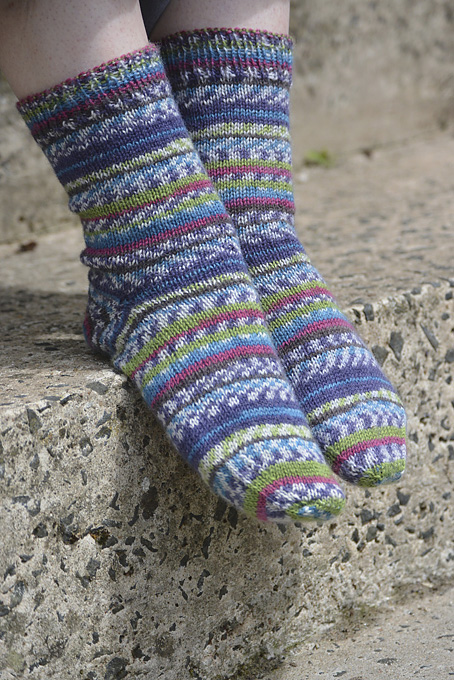
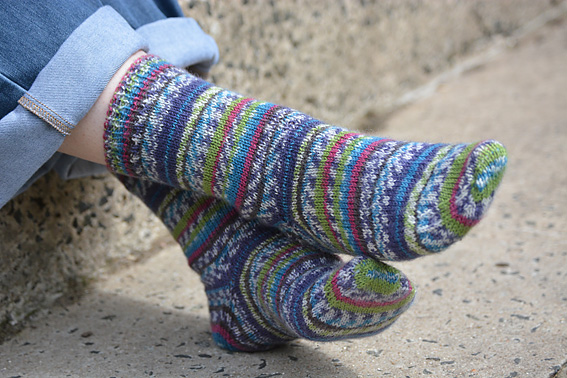
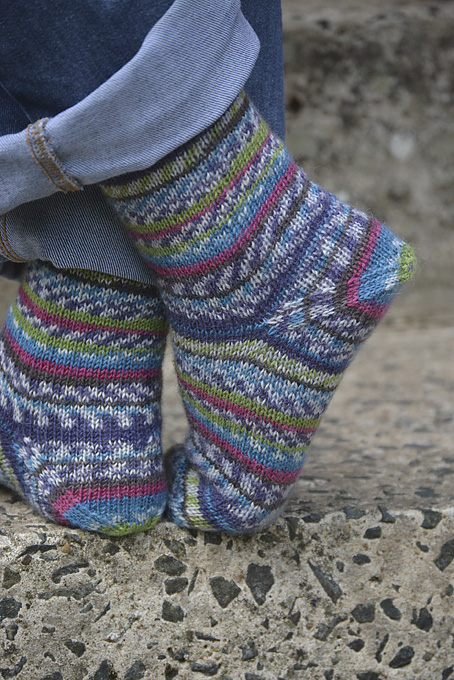
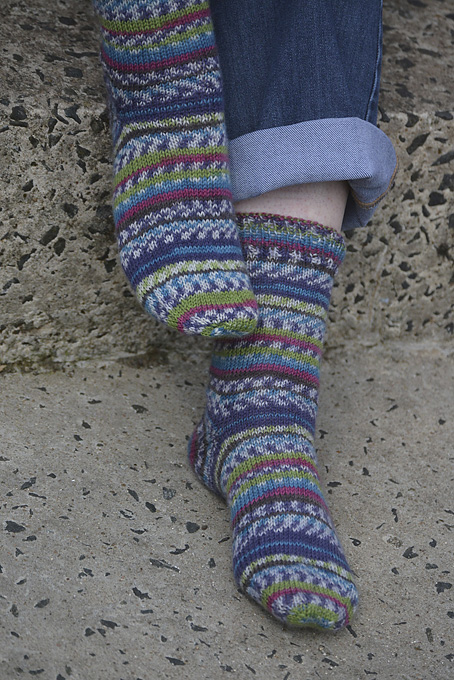
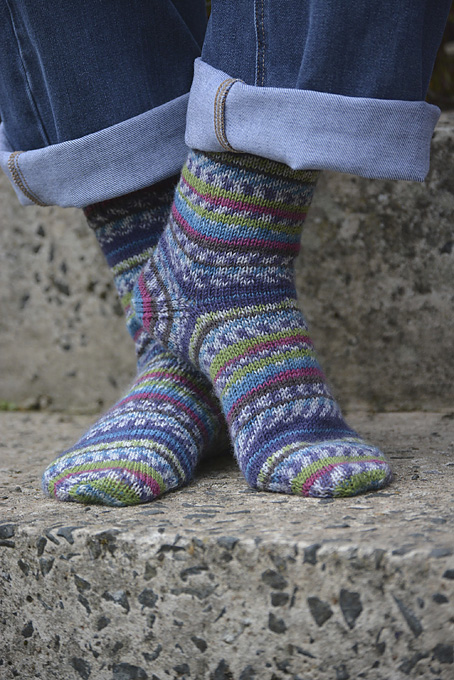
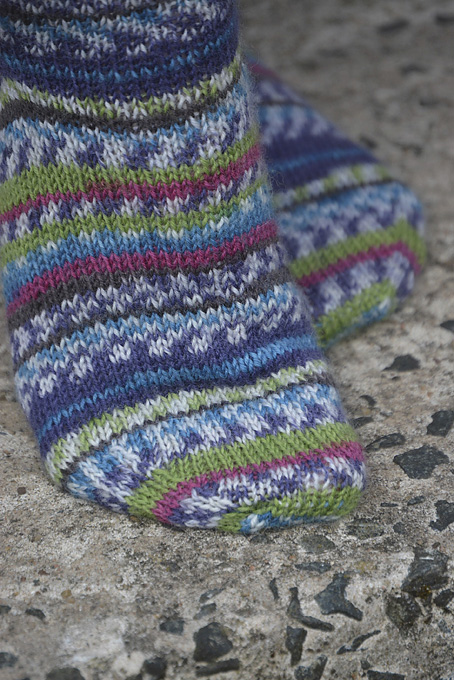
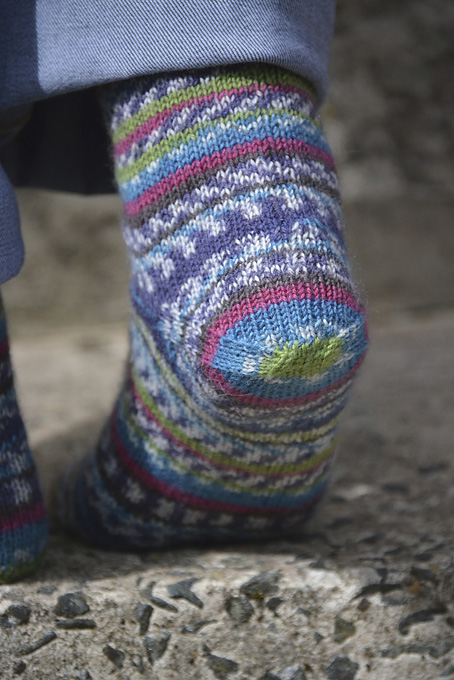
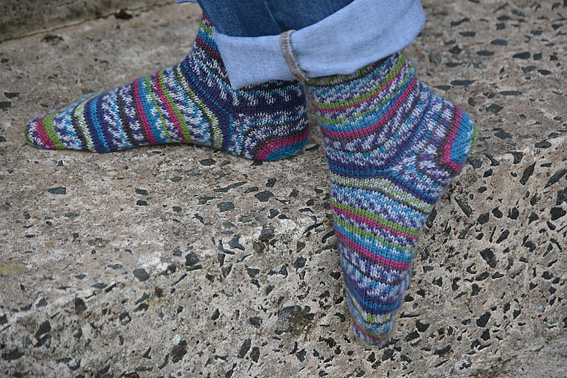
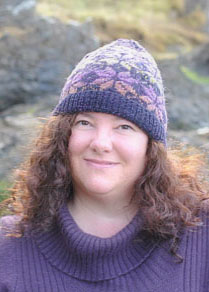
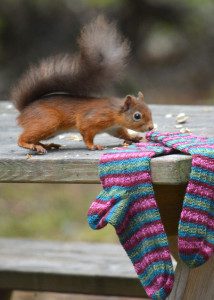
Kristin Nicholas lives not too far away from me! I have taken embroidery on knits classes with her several times. She is quite an artist. Have you seen her blog? http://getting-stitched-on-the-farm.blogspot.com/ Enjoy! Kate
Thank you for the link to Kristin Nicholas’s blog. I have two of her books which I’ve very much enjoyed reading. She has such an amazing sense of colour. And her home… wow! You are so lucky to have attended a few classes with her. Many thanks, Nicolette.
I’ve the Regia Snowflake and am really excitied to start knitting my socks. I am a novice sock knitter. I plan to make them both at the same time (as you’ve suggested) and use your pattern above however I am unable to find the size foot these would fit. I don’t want to spend hours of knitting, only to discover that they are too big 🙁 How do I adjust the pattern for a Women’s size 4 (UK)?
Hi Min,
I’ve been thinking about your question and looking up my sock knitting books. Most of the books are written for US sizes and aren’t very helpful and even with European and UK sizing the directions vary. I know that with my own first couple of pairs of socks and even now countless socks later, I am always tweaking the number of rows for the leg or foot which can change depending on the style of heel and toe as well as the weight and/or make of sock yarn. I knit my socks for a UK size 5/6 using a tension of 30 sts/42 rows = 10x10cm (4×4″) or 7.5 sts/10.5 rows = 2.5×2.5cm (1×1″) knitting stocking stitch in the round using 2.75mm bamboo double pointed needles. The circumference of my foot is 8.5″. You don’t want your socks to be too loose. So, 8.5 (foot circumference) x 7.5 (tension) = 63.75 stitches. I like to knit my socks with a little negative ease. So, 63.75 ÷ 100 x 95 = 60.56 stitches. So I cast on 60 stitches for knitting my socks.
For a UK size 4 using a tension of 30 sts/42 rows = 10x10cm (4×4″) or 7.5 sts/10.5 rows = 2.5×2.5cm (1×1″). It is helpful to measure the circumference of your foot which will allow you to know more accurately how many stitches you should cast on. But the numbers that I came up with from doing some research was, using 4 ply sock yarn, cast on 56 stitches/ 14 stitches per needle. I would advise for a first sock knitting a heel flap/turning heel/gusset, so you’d knit 28 rows on 28 stitches for the heel flap. Pick up and knit 14 stitches at either side of the heel flap. Once you’ve finished decreasing for the gusset and after knitting about 25 rounds for the foot, try the sock on. When the foot section has reached the knuckle on your big toe, start the decreases for a classic toe.
This is not an easy question to answer as so many elements can change the outcome, tension, needle size (many patterns suggest anything from 2-3mm), whether you are knitting a basic sock. If you are adding any type of pattern that involves colour work, cabling, or travelling stitches, you will need to cast on extra stitches to allow for this. For example, when I am knitting a sock in fair isle colour work, I need to cast on 72 stitches instead of my normal 60 stitches as the stranded work has a lot less stretch to it.
Actually, I think this subject needs a post to itself, but in the meantime, I hope this helps you. Happy sock knitting, Nicolette
Thank you so much for your detailed reply. I’m starting the tension square tonight. 😀